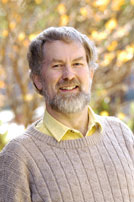|

|
Professor Jeffrey R. Reimers
School of Chemistry F11, The University of Sydney, Australia
|
Abstract: Quantitative agreement has been found between observed and calculated charge mobilities through organic conductors, despite the use of many assumptions in the calculations, including: the relative strength of the intermolecular electronic coupling to the reorganization energy driving charge localization, the treatment of site variability in the material, the involvement of tunneling processes during charge hoping between sites, the use of weak-coupling based perturbation theory to determine hopping rates, the residence times for charges on sites, the effect of the large field strengths used in experimental studies, the general appropriateness of simple one-dimensional diffusion modeling approaches, and the involvement of molecular excited states of the ions. We investigate the impact of these assumptions, concluding that all may be very significant. In some cases methodological options are considered and optimum procedures determined, showing (i) that the use of Koopmans' theorem to estimate intermolecular couplings in solids is problematic, and (ii) the correct expression for the residence lifetime of a charge on a crystal site. These conclusions are drawn from simulations of anisotropic charge mobilities through the phase of mer-tris(8-hydroxyquinolinato)aluminum(III) (Alq3) crystal, a material commonly used in OLED applications. Calculations are compared that determine mobilities at finite applied field from drift velocities through either semi-analytical solutions of the master equation or else kinetic Monte Carlo simulations, as well as those that determine mobilities from multi-dimensional diffusion coefficients at zero field by Monte Carlo and those that analytically solve simplified one-dimensional diffusion models. For crystalline Alq3 itself, the calculations predict electron mobilities that are 4-6 orders of magnitude larger that those predicted by similar methods for amorphous Alq3, in agreement with experimental findings. This work vindicates recent theories describing the poor mobilities of the amorphous material, forming a complete basic picture for Alq3 conductivity.
About the Speaker: Jeffrey R. Reimers was awarded a BSc with honours from ANU in 1978, studying chemical spectroscopy, and then his PhD from ANU in 1983, studying the structure and spectra of liquid water with Prof. Robert Watts. His Post-doctoral Fellowship was with Prof. Kent Wilson at the University of California, San Diego, co-supervised by Prof. Eric Heller from Los Alamos National laboratories and thence The University of Washington, studying semi-classical methods in spectroscopy. In 1986 Jeff returned to Australia with a QEII Fellowship at the University of Sydney. Since then Jeff has remained at this university, continually being awarded ARC Research Fellowships, and most recently in 2005 being awarded an ARC Professorial Fellowship. Jeff was promoted to Professor by The University of Sydney in January 2007.
Jeffrey R. Reimers is a Fellow of the Royal Australian Chemical Institute (RACI), and an active committee member of the national Physical Chemistry Division within the RACI. On RACI and other committees Jeff has been involved in the organising of many conferences over the years, including the 2005 RACI National Convention and US Engineering foundation conferences on Molecular Electronics. He has edited several books on Molecular Electronics and has delivered invited and contributed lectures at various conferences and symposia both in Australia and overseas on topics including molecular electronics, photosynthesis, spectroscopy, and electronic-structure computational methodology. As a theoretical chemist, Jeff's main research interests include electronic devices, photosynthesis, photovoltaics, molecular electronics, chemical spectroscopy, solvation, and electronic-structure computation methods. Continuous research funding from the Australian Research Council since 1985 is in excess of A$5 million. In this time Jeff has published over 130 peer-reviewed articles in journals of international repute.
Date&Time: August 17, 2012 (Friday) 10:30-11:30a.m.
Location: 606 Conference Room, No.3 Heqing Road, Haidian District


